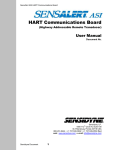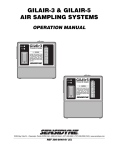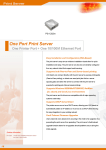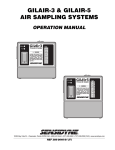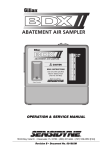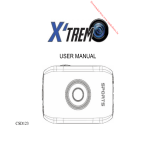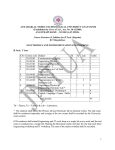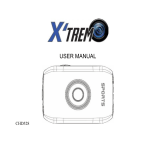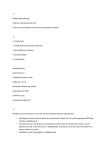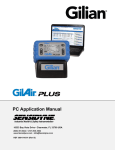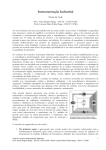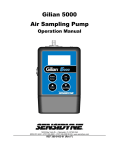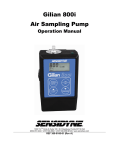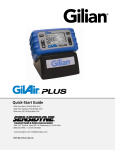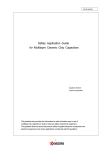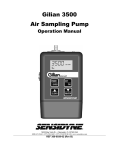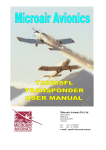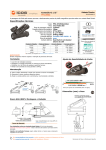Download Sensidyne Gilian Challenger NIST-Traceable Calibrator User Manual
Transcript
Laboratory/Field Audit Calibrator NIST Traceable – ISO 9001:2000 1 TO 30 Lpm Sensidyne, LP • 16333 Bay Vista Drive Clearwater, Florida 33760 USA 800-451-9444 • +1 727-530-3602 • +1 727-539-0550 [fax] web: www.sensidyne.com • e-mail: [email protected] Gilian Challenger Air Calibrator Important Note If for any reason you are uncertain as to which Venturi is installed, recycle the I/O (off/on) switch. During boot up, the bottom line on the screen will read SN XXXXXXL which indicates that the 1-6 lpm range unit is installed. SN XXXXXXH, indicates that the 6-30 lpm range unit is installed. Table of Contents. Section Topic Page 1.0 Quick Start 4 2.0 Introduction 4 3.0 Specifications 6 4.0 Principle of Operation 10 5.0 Instrument Set Up 10 6.0 Using the Calibrator 11 7.0 Software 13 8.0 Maintenance 13 9.0 Safety 13 10.0 Warranty 13 Appendix A NIST Traceability 14 Appendix B Lubrication 16 Appendix C Volumetric and Mass (Standard) Flow 16 Sensidyne Document No. 360-0110-01 (Rev B) 3 Gilian Challenger Air Calibrator 1.0 Quick Start In order to put the instrument to immediate use as a Calibration/Audit device, follow these steps. Step 1: Remove the instrument from its carrying case and turn it on. Step 2: Install the correct Venturi for the flow rate range of interest. #H 6-30 Lpm #L 1.0-6 Lpm Note: The Deluxe Model includes both Venturis. The Low Flow Model includes only the #L Venturi and the High Flow Model includes only the #H Venturi. Step 3: Provide tubing of the appropriate diameter to connect the Venturi to the instrument being audited/calibrated. Step 4: With air flowing, you may now read the screen to determine volumetric flow rate, ambient temperature and barometric pressure. For a diagram of the immediate application refer to Figure 1. Note: A Venturi MUST be matched to a unit by serial number. Swapping a Venturi from one Challenger to another will cause accuracy loss. 2.0 Introduction The Challenger air flow calibrators are manufactured for Sensidyne, LP by BGI, Inc. All Challenger calibrators are based on the air flow measurement principle of the Venturi1. Our calibrators are manufactured in an ISO 9000:2000 facility. The instruments provide an LCD indication of Volumetric and Standard flow rate, barometric pressure and ambient temperature. It operates on four AA alkaline energy cells (batteries).The electronics are all housed in the control module. The instrument is furnished with two auto ranging Ventura, which cover the flow rate range of 1 to 30 Lpm. 4 Sensidyne Document No. 360-0110-01 (Rev B) Gilian Challenger Air Calibrator Sensidyne Document No. 360-0110-01 (Rev B) 5 Gilian Challenger Air Calibrator Figure 1 – “Quick Start” Application of Challenger 3.0 Specifications Flow rate range: 1 – 30 LPM (± 0.75% or less) (Deluxe Model) 1 – 6 LPM (± 0.75% or less) (Low Flow Model) 6 – 30 LPM (± 0.75% or less) (High Flow Model) -30° C to 55° C -30° C to 55° C (± .5° C) 400 to 800 mm of Hg (± 5mm) 533 to 1067 mb Temp. operational range Temp. reading range Barometric pressure range Dimensions: Control Module: 1.59 in. high ( 4.04 cm) X 3.90 in. wide ( 9.91 cm) X 7.70 in. long ( 19.61 cm) Weight w/ Venturi 7.4 oz (209 g) One complete instrument comprises: 6 Quantity Description Catalog/Part No. 1 Challenger 811-9911-03 4 Installed AA batteries Replacements obtained locally by user 1 Instruction Manual Enclosed CD 1 Carrying Case 7013586 1 Software Disk 615-9901-01 1 Venturi H, 6-30 lpm Contact Factory 1 Venturi L, 1-6 lpm Contact Factory Sensidyne Document No. 360-0110-01 (Rev B) Gilian Challenger Air Calibrator Replacement supplies (not included with initial purchase). 1 Pkg. of 3 Venturi socket “O” rings 811-9913-01 VENTURI (3) O-RINGS THROAT TAP UPSTREAM PRESSURE TAP VENTURI HOUSING AIR FLOW PATH 3060 Figure 3 – Sectional View of Measuring Head Sensidyne Document No. 360-0110-01 (Rev B) 7 Gilian Challenger Air Calibrator AIR FLOW TEMPERATURE PROBE DIFF. PRESSURE SENSOR VENTURI MICRO PROCESSOR TO SAMPLER BAROMETRIC PRESSURE SENSOR BP Ta Qa Qs :760mm 1013mb :22.8 :10.02LPM Batt :10.10LPM 100% LCD DISPLAY SCREEN Figure 4- Schematic Diagram of Challenger 3061 8 Sensidyne Document No. 360-0110-01 (Rev B) Gilian Challenger Air Calibrator RS232 PORT VENTURI ON / OFF SWITCH THERMISTER HOUSING Figure 5 – Challenger Assembly Sensidyne Document No. 360-0110-01 (Rev B) 9 Gilian Challenger Air Calibrator 4.0 Principle of Operation The calibrator measures volumetric flow rate by utilizing a pressure transducer to assess the pressure drop caused by air being drawn through a Venturi. As the flow rate through the Venturi increases, the pressure drop increases as the square root1. A four times increase in pressure drop yields twice the flow rate. A desirable feature of the Venturi is that most of the pressure drop created by the instrument is recovered in the expansion section of the Venturi. Therefore, measurements are made at nearly the true operating conditions of the sampler. The signal from the pressure transducer is sent to the microprocessor where, it is combined, via an algorithm with information from the barometric pressure sensor and the ambient temperature sensor. To eliminate “fluttering” of the on screen display, of flow rate, the first 20 readings are averaged and then carried on as a rolling average. Barometric pressure and temperature are monitored and displayed on a continuous basis, when the instrument is switched on. A cutaway diagram of the measuring head is shown in figure 3 and a schematic diagram of the system is shown in Figure 4. 5.0 Instrument Set-up Remove the instrument from its carrying case. The only control is an off/on switch on the end cap. Switch the instrument on and the screen will boot into the main idle display screen for whatever Venturi is installed. If no Venturi is installed, or the low range is installed then the boot screen will look like this: The Challenger Version 2.500 SN000004-L If the low range is installed no change will occur, to the screen. If the high range was installed or it is now installed, there will be a brief message: VENTURI CHANGED The boot screen will then have the following appearance: The Challenger Version 2.500 SN000004-H A Venturi is changed (installed) in the following manner. With the Venturi held vertically, plain end downwards (hose nipple up), plunge the Venturi into the hole in the top of the socket with a slight rotary motion. Be certain that there is sufficient lubricant on the “O” rings within the recess. (See appendix B about lubrication). At this point the instrument will automatically reboot and autorange to the selected Venturi. BP Ta Qa Qs 10 :760mm 1013mb :22.8 :10.02LPM Batt :10.10LPM 100% Sensidyne Document No. 360-0110-01 (Rev B) Gilian Challenger Air Calibrator Using a short length of elastomeric tubing, connect the sampler under test to the top of the Venturi and turn it on. The volumetric flow rate will now appear on the screen as shown above. Important points to be noted concerning the utilization of the calibrator A. When starting the Venturi must have no air flowing through it. Every time the instrument is switched on, it re-zeros itself. If air is flowing, that flow rate will be set as zero. B. In order to perform the most precise measurement audit, it is necessary for the device to be in thermal equilibrium with the ambient environment in which the sampler to be tested is located. The best procedure is to deploy the calibrator for 10 minutes prior to the test, in the vicinity of the sampler to be audited. Additionally, if the calibrator is subject to a temperature change of more than five degrees, during use, it should be removed from the flowing air and rebooted. C. When the calibrator is switched on XX % battery is displayed on the screen. So long as more than 10% is indicated, it is safe to proceed, in that, at least one hour of power is available. The test is now ready to be performed. D. Never use a Venturi in a Challenger if the serial numbers do not match. Venturi and Challenger are factory calibrated as a unit. 6.0 Using the calibrator 6.1 To perform an audit One of two procedures should now be performed. Procedure A. Turn off the sampler to be audited. Connect the calibrator to the inlet to the sampler with, user provided tubing. Turn on the calibrator, wait for the screen to finish the startup boot, then turn on the air sampler. Procedure B. With the sampler to be audited running, when the calibrator screen has finished its startup boot, connect the measuring tube to the instrument under test When using Procedure B, connecting tubing to a running pump, may cause momentary instability in the air samplers flow control circuit. Once the air samplers flow rate indicator stabilizes, the reading may be taken. A simple audit data format is shown in Table 1. This may be taken as a guide to designing a form suitable for your specific needs. 6.2 To perform a calibration. The procedures and calculations for using the instrument to calibrate a sampler are the same as an audit, except that one should set the sampler to the exact flow rate required. Sensidyne Document No. 360-0110-01 (Rev B) 11 Gilian Challenger Air Calibrator Table 1 Audit Data Format Audited Instrument: Make:___________________________ Model:_____________________ S/N:________________ Date:__________________ Time:________________ Calibrator S/N:________________________ Flow Rate – Lpm Sampler:___________ Calibrator:___________ % diff. = [(Calibrator-sampler)/ Calibrator]x100 Allowed diff. = 4%; Pass________ Fail_________ Ambient Temp. – C Sampler:___________ Calibrator:___________ Allowed diff. = ± 2 C; Pass________ Fail_________ Barometric Pressure – mm of Hg Sampler:___________ Calibrator:___________ 12 Allowed diff. = ± 10 mm; Pass________ Fail_________ Sensidyne Document No. 360-0110-01 (Rev B) Gilian Challenger Air Calibrator 7.0 Software Software for the Challenger is subject to upgrade periodically. Contact Sensidyne to see if your unit may be upgradeable to the latest version. 8.0 Maintenance Beyond battery replacement, the only part of the instrument requiring attention is the flow passage through the Venturi. After long periods of use, some atmospheric dust can coat the interior flow surfaces. The presence of such a deposit may be ascertained by viewing the interior of the Venturi under bright light; direct overhead sunlight being preferable. Glance into the interior, from either end, seeking any discoloration of the surface. If it is determined that cleaning is required, use the following procedure. Rinse the entire Venturi body in warm soapy water. Any deposits, which are not floated away, may be removed externally with a soft cloth. If internal deposits are not removed by soaking, the best procedure is to immerse the unit in an ultrasonic bath containing soapy water. If an ultrasonic bath is not available, judicious use of a pipe cleaner is recommended. Following cleaning, the Venturi may be dried utilizing compressed air, or if not available, allowed to air dry. 9.0 Safety There are no owner serviceable components in the instrument other than the Venturi socket “O” rings and the four AA batteries. These should only be replaced with good quality alkaline energy cells and should be promptly removed when expired, to prevent leakage and chemical damage to the electronic components. When the instrument is placed in long term storage (more than two months) always remove the batteries. Even though there is no reason to disassemble the electronics box, should the need arise, always remove the batteries before proceeding further. Adjustable potentiometers are contained within the electronic housing, which are factory set during calibration. If these are turned, the calibration will be lost and factory recalibration will be required. 10.0 Warranty Information Sensidyne warrants this equipment to be free from defects in workmanship and material. We make no warranty, express or implied, except as set forth herein. Sensidyne's liability under this warranty extends for a period of one (1) year from the date of Sensidyne's shipment. It is expressly limited to repairing or replacing at the factory during this period and at Sensidyne's option, any device or part which shall within one year of delivery to the original purchaser, be returned to the factory, transportation prepaid and which on examination shall in fact be proved defective. Sensidyne assumes no liability for consequential damages of any kind. The purchaser, by acceptance of this equipment, shall assume all liability for consequences of its misuse by the purchaser, his employees or others. This warranty will be void if the equipment is not handled, installed, or operated in accordance with our instructions. If damage occurs during transportation to the purchaser, Sensidyne must be notified immediately upon arrival of the equipment. Return transportation charges are collect. Sensidyne Document No. 360-0110-01 (Rev B) 13 Gilian Challenger Air Calibrator A defective part in the meaning of this warranty shall not, when such part is capable of being repaired or replaced, constitute a reason for considering the complete equipment defective. Acknowledgment and approval must be received from Sensidyne prior to returning parts or equipment for credit. Sensidyne makes engineering changes and improvements from time to time on instruments in its product line. We are under no obligation to retrofit these improvements and/or changes into instruments which have already been purchased. No representative of ours has the authority to change or modify this warranty in any respect. Appendix A. NIST Traceability A1.0 Introduction NIST traceability for the calibrator is established with the use of devices which are of themselves traceable and for which, the factory holds current traceability certificates. Calibrations are performed under a set of ISO 9001:2000 procedures, subject to annual audit. During a flow rate calibration, the room temperature is established with an ASTM certified/traceable thermometer. Barometric pressure and absolute pressure are established with electronic manometers. These are backed by three Primary Standard Mercury Instruments/ A2.0 Flow Rate Calibration A schematic diagram of an instrument undergoing flow rate calibration is shown in Figure 1A. Two traceable critical Venturi are utilized for this purpose. While the calibrator utilizes barometric pressure and ambient temperature to constantly display readings of volumetric flow rate, the initial Venturi calibration is performed and normalized to a base value. While any values are sufficient, “Engineering Standard Values” of 20C and 760mm of Hg have been selected. Utilizing an Excel spreadsheet, the flow rate vs. pressure drop equation for each individual Venturi, under test, is determined. This equation is then installed in the individual units microprocessor. A3.0 Barometric Pressure Calibration The barometric pressure sensor is set to match the actual current barometric pressure as determined by a Mercury barometer. A negative pressure of 150 mm of Hg is applied to the barometric pressure transducer and the output reading is adjusted to comply with BP – 150mm. A4.0 Temperature Calibration The Thermistor provided for measurement of ambient temperature is of a very high standard and are batch tested at the temperature extremes of –20 C and +55 C, utilizing an ASTM certified/traceable thermometer as a reference. 14 Sensidyne Document No. 360-0110-01 (Rev B) Gilian Challenger Air Calibrator DIGITAL TEMPERATURE VACUUM PUMP 20° C MERCURY BAROMETER TRACABLE CRITICAL VENTURI MERCURY MANOMETER VENTURI PRESSURE DROP MANOMETER CALIBRATOR VENTURI CONTROL VALVE Figure A1- Schematic Diagram of Calibration Setup 2313 Sensidyne Document No. 360-0110-01 (Rev B) 15 Gilian Challenger Air Calibrator A5.0 Recalibration Recalibration is immediately necessary if physical damage has occurred to such an extent that the instrument is rendered inoperable. In such cases, an instrument will be recalibrated as part of the repair procedure. There are no moving or wear parts in the instrument, therefore, baring physical damage, there is no reason for recalibration, except as required by ISO, company or regulatory requirements. These requirements are almost universally on a one-year basis, after being placed in service. Units received for recalibration will be thoroughly inspected and any requisite repairs will be performed prior to recalibration. Appendix B. Lubrication There is one point which requires careful lubrication it is the three “O” rings inside the socket into which the Venturi is inserted. They should be sparingly lubricated with the tip of the finger. General purpose automotive grease seems to be the most successful all around lubricant. Appendix C. Volumetric and Mass (Standard) Flow. There are two ways that practitioners of air sampling measure and talk about flow rate. Those doing compliance sampling for Industrial Hygiene/Occupational Health speak of Volumetric or Actual Air Flow rates. It is the volume of air at the existing pressure and temperature at the sampling site. The US EPA also specifies this type of measurement for PM2.5. Electronic meters usually read out in volumetric flow rate or QA. Mass flow meters read out in Qs. The Challenger reads out in both. EPA, for Politico Legal, reasons uses QS known as Standard or Mass Air flow rate for reporting PM10. This means that the flow rate is reported to Standard conditions. For the US EPA, these conditions are 25 C and 1 atmosphere pressure. (1 Atmosphere = 760 mm of Hg = 29.92 in of Hg = 1013.25 millibars = 1013.25 hecto Pascals). Because the mass of air flowing could be calculated from QS it has come to be called Mass flow. Throughout most of the world QS is not usually referred to as mass flow and it is to a different standard. The conditions outside of the U.S. are 0 C and 1013.25 mb. The equations relating QA. and QS are: QS = Qa * (BPa/760)*(298.15/(Ta+273.15)) For U.S. applications when Ts=25 C and BPs=760 mm of Hg QS = Qa * (BPa/1013.25)*(273.15/(Ta +273.15)) For world applications when Ts=0 C and BPs=1013.25 mb The screen which is the output of The Challenger is explained below: 16 Sensidyne Document No. 360-0110-01 (Rev B) Gilian Challenger Air Calibrator BP in hecto Pascals (millibars) BP in mm of Hg Running on battery Power Ambient Temp. BP Ta Qa Qs :760mm 1013mb :22.8 :10.02LPM Batt :10.10LPM 100% Actual Flow Rate at Local BP and T Ambient Standard Flow Rate (Actual Corrected to Standard Conditions) 3064 References 1. 2. 3. Fan Engineering, R. Jorgensen, ed. Buffalo Forge Co, Buffalo, NY. 6th Ed. 1961. US EPA FRM 40 CFR Part 53, Federal Register, July 18, 1997. Measurement Systems, E.O. Doeblin, McGraw-Hill Inc., New York, NY. 4th Ed. 1990. Sensidyne Document No. 360-0110-01 (Rev B) 17 Notes Sensidyne, LP • 16333 Bay Vista Drive Clearwater, Florida 33760 USA 800-451-9444 • +1 727-530-3602 • +1 727-539-0550 [fax] web: www.sensidyne.com • e-mail: [email protected] U KA S AMTAC MEDIQA QUALITY MANAGEMENT 061 ISO 9001:2000 Registered




















